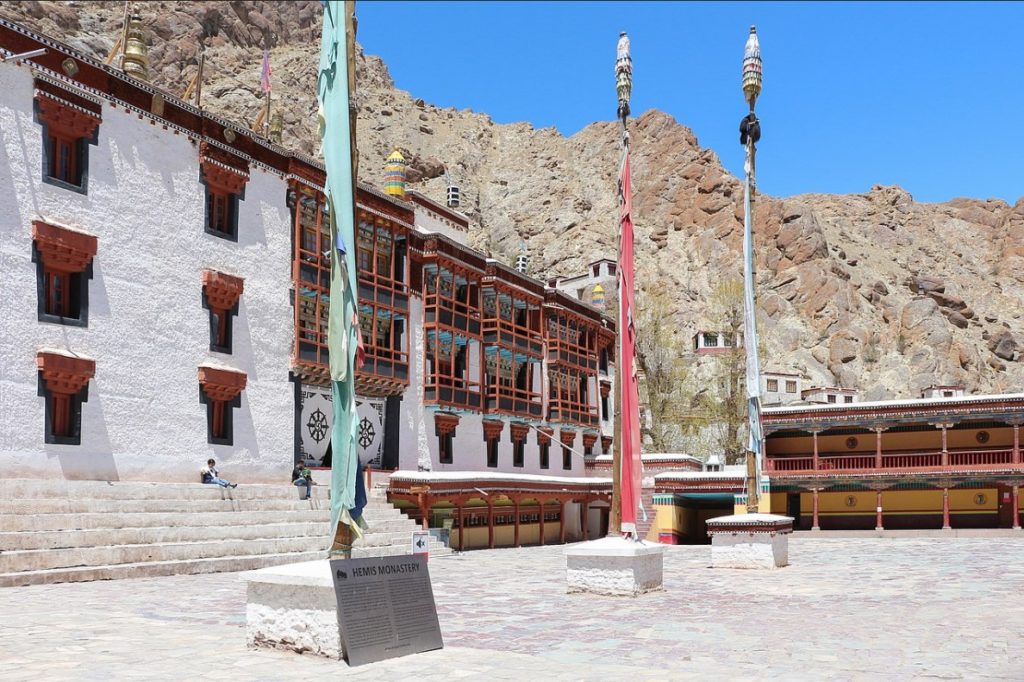
Hemis is located 45 km to the south of Leh on the western banks of the river Indus. Amidst this breath-taking scenery is the Hemis monastery – one of the biggest and richly endowed monasteries in Ladakh. The Hemis monastery was built in 1630 CE, and was established in 1672 CE. This is unlike any other monastery one could come across. Decorated with colourful prayer flags on all four sides, it is believed by many that when these flags flutter in the wind, the breeze sends prayers to the Lord Buddha.
The Hemis monastery also has a library located in the vicinity which has a valuable number of Tibetan books with an impressive and priceless collection of thangkas as well. A Thangka is a Tibetan-Buddhist painting on cotton, silk appliqué and it usually depicts a Buddhist deity, scene, or a maṇḍala. According to the Buddhist traditions, the thangkas are to be kept unframed and must be rolled, when not in use. One can also see gold statues along with stupas embedded with many precious stones in the monastery complex.
The Hemis festival is held in the Hemis gompa annually and is celebrated over two days in June or July to mark the birth anniversary of Guru Padmasambhava – the father of tantric Buddhism, who is also called Guru Rinpoche (the Precious Guru). The tenth day of the lunar month according to the Tibetan Calendar marks the beginning of this vibrant festival. According to the Buddhist traditional belief, this festival is the joyous occasion of the dominance of good over evil. It reflects on the history, tradition, and the Buddhist culture of the region. One would not be wrong to say that visitors can witness and be a part of one of the most extraordinary displays of Tibetan cultures in India.
Guru Padmasambhava was the one who established the first Buddhist monastery in Tibet. His teachings are closely followed by the claimants of old-order; Rnying-ma-pa sect. His practices are broadly based on tantric rituals, worship and yoga. As per studies, Guru Padmasambhava fought against evil to save his followers. Hence, it is only fitting that the Hemis Festival is dedicated to that victory as a mark of respect to the Guru.
The proceedings and rituals of the festival take place in the courtyard of the monastery, directly facing the front door. The courtyard is rectangular in shape with a sacred-circular post in the Centre. Several musicians play traditional music with four pairs of cymbals, large-pan drums, small trumpets, and large-sized wind instruments.
Another intriguing part of this festival is its rituals. The main attraction is the presentation of a mask dance-drama. These mask-dances of Ladakh valley are collectively referred to as chams dance. The chams dance or performances were a part of the Buddhist tantric tradition – essentially in those gompas/monasteries that follow tantric Buddhism. They are strictly performed in adherence to the orally transmitted prescribed texts and the theme is usually taken from mythological legends. It is performed with elaborate masks and costumes, symbolizing various meditative and protective deities. More interesting is the fact that the monks of the monastery assume the personage and personality of the deity they are meant to characterize. This is followed by a dance around the central pole, accompanied by their slow and solemn movements of legs and hands to the special music of drums, cymbals and wind-instruments.

This engaging act gains further momentum when thirteen dancers adorning black hats with round rims enter the central area, dancing around the pole in a clockwise direction. They have red ribbons flowing down the back of their black hats. Their robes are heavy and made of rich Chinese silk with brocade while their costume is completed with rich capes and aprons with a necklace bearing a skull emblem. This skull emblem is considered to be a potent symbol against evil. Each one of them is given a dried sacred herb by a lama as they slowly move towards their exit.
The purpose of this tantric dance is to dispel the evil forces and mark out the exterior limits of the performance space by binding the quarters with their sacred movements. The number thirteen is identified by the thirteen yugas of the cosmos and the thirteen rings of the Chorten (stupa). The festival is filled with many other types of ritual dances such as the dance honouring the eight aspects of the guru, the dance of the protectors, the dance of the turgid, the dance of the Herukas among others.
However odd it may seem like, the people of Ladakh are not without their popular chang drink. It is made from rice water infused with other ingredients that give it an exquisite taste. This local drink holds a similar significance of bhang during Holi and sevaiyan during Eid. It is one of the highlights of the festival besides the handicraft exhibition.
One cannot close without a discussion on the rich and colourful history of the region. It has a unique vibe to its culture than the rest of the Indian subcontinent and yet at the same time, it is very similar to the one followed in Tibet as well as Central Asia. The people traditionally lead a nomadic lifestyle, giving prominence to agriculture and sheep-rearing. The Ladakhi women, unlike other parts of the Indian subcontinent, hold a prestigious and respectful position in the society with greater freedom.
The Hemis festival gathers visitors from around the world which is rooted in the history and culture of Ladakh known as mini Tibet. The festival can also be viewed as an inheritance – a legacy which has been carried forward by the people of Ladakh. It truly provides a once in a lifetime experience to its attendees – a sight to behold!
Ritika is a museum enthusiast and likes to explore the diverse arts, culture and heritage of India. Living in a country which has been the storehouse of history in its every nook and crannies, it becomes really difficult for her to remain aloof from it for long. She believes that the community needs to know about this and this is what she is striving to achieve.



Woah! I’m really enjoying the template/theme of this
blog. It’s simple, yet effective. A lot of times it’s hard to get that “perfect balance” between usability and visual appearance.
I must say you have done a fantastic job with this.
Also, the blog loads super quick for me on Chrome.
Superb Blog!